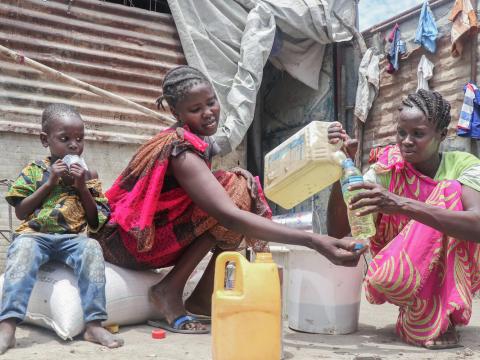Seven million people at risk of starvation across six countries in East Africa

31 March, 2021 – More than seven million people across six countries in East Africa are on the brink of starvation. If the international community does not act now, thousands of children could face long-term health consequences or die, warns World Vision International.
Andrew Morley, World Vision International President & CEO, said: "The world needs to wake up now. Millions of children are being pushed to the brink of starvation. They are facing a deadly cocktail of conflict, climate change and the crushing aftershocks of COVID-19. I’ve seen first-hand the devastating impact of malnutrition in many places we work. It robs children of their childhood, denying them the opportunity to achieve their God-given potential.”
It is estimated that more than 108,000 people in East Africa are under catastrophic famine-conditions, marked by critical acute malnutrition, starvation, destitution and death. Additionally, almost 7 million people are one step away from famine, and as many as 26 million require urgent action to prevent them sliding into the same acute situation.
“We are marshalling resources to support vulnerable communities across East Africa, to avert the catastrophic effects of hunger, starvation and loss of livelihoods particularly on children,” said Joseph Kamara, Regional Humanitarian and Emergency Affairs Director for World Vision East Africa. “It is not too late to avert the crisis, but it will be soon, if we don't act quickly and decisively.”
The East Africa region has endured substantial and widespread breeding of desert locusts since late 2019, resulting in loss of pasture and crops. During the second half of 2020, large-scale floods destroyed ready to harvest crops of more than four million people across the region. Furthermore, the region is gripped by protracted crises and fragility in several countries compounded by the new conflict in Tigray, Ethiopia, which has dramatically increased food insecurity.
The situation also increases risks faced by women and girls, including gender-based violence and sexual exploitation and abuse. The indirect impacts and aftershocks of COVID-19 also persist for children and their communities in the region, where there is a decline in income opportunities, lost livelihoods, diminished purchasing power and limited access to basic food and services, in contexts without welfare safety nets.
“A combination of hazards such as insufficient rainfall, desert locusts, the previous year's floods that destroyed mature crops prior to the harvest and the effects of COVID-19 have fermented this critical situation,” said Kamara. “The humanitarian response to each of these issues has been limited by insufficient funding due to competing humanitarian needs in other regions,” said Mr Kamara.
World Vision has declared a multi-country emergency response for Ethiopia, Somalia, South Sudan, Sudan, Kenya and Uganda. It aims to reach approximately 2.4 million people, including 490,000 children, and needs US$60 million to mobilise and extend its hunger crisis response. The organisation is already responding with food distributions in multiple countries but current funding cuts and expected tightening of aid budgets are coming at the wrong time.
This challenging period also has long term consequences, and could erode human and economic development gains that have been made towards the global Sustainable Development Goals across the region.
“In the face of unprecedented global demands for humanitarian funding, crises in East Africa are receiving limited international attention, despite urgent and life-threatening needs,” said Kamara. “We appeal to national governments, regional institutions, humanitarian actors and donors to urgently address the hunger crisis in East Africa and more forcefully communicate its breadth and severity.”
World Vision is already working in response countries and currently reaches more than 400,000 children in Kenya, Uganda and Ethiopia through its sponsorship programme. In 2020, the organisation reached more than 4.7 million children through its multi-sector interventions in Ethiopia, Kenya, Uganda, Sudan, Somalia, and South Sudan.
“Let me be direct: there is no place or excuse for famine in the 21st century. We have the resources and technology to feed the world. The fact we have reached this point shows there has been a clear and catastrophic moral failure by the international community. A generation of girls and boys needs us to bring hope. Children of the world are looking to us to act,” said Andrew Morley.
ENDS.
Note to editor:
For further information or to organise an interview, please contact:
Jennifer Watson - Regional Communications & Public Engagement Director – East Africa Email: Jennifer_Watson@wvi.org - Phone: +254 780 55 43 94
World Vision is a global Christian humanitarian, development and advocacy organisation dedicated to working with children, families and their communities to reach their full potential by tackling the root causes of poverty and injustice. World Vision serves all people, regardless of religion, race, ethnicity or gender. For more than 40 years, World Vision has partnered with communities in nine countries across East Africa: Burundi, Ethiopia, Kenya, Rwanda, Somalia, South Sudan, Sudan, Tanzania and Uganda. Our strategy is a promise to build brighter futures for vulnerable children in East Africa. World Vision integrates the global Sustainable Development Goals into its own development and emergency-response programming. For more information, please visit www.wvi.org or follow us on Twitter @WorldVisionEARO and @WorldVision